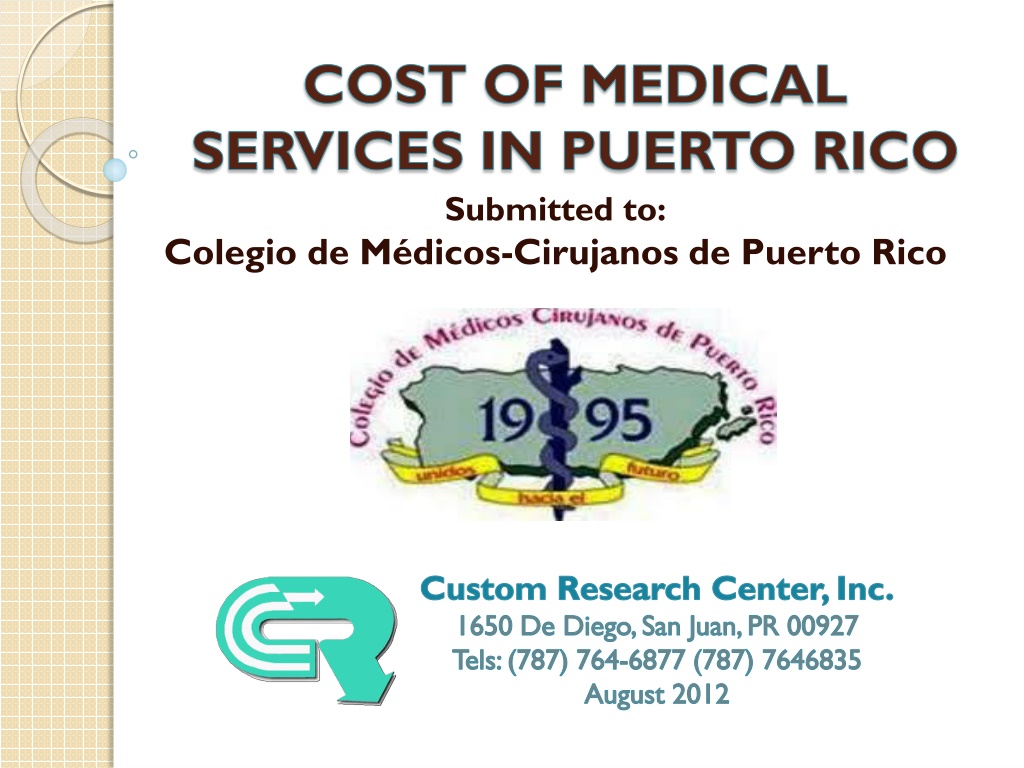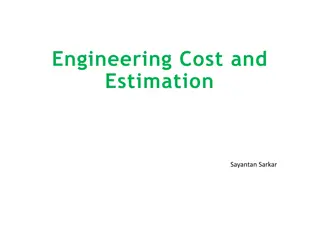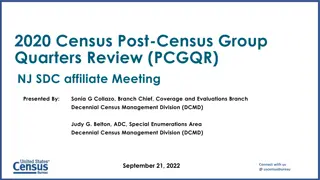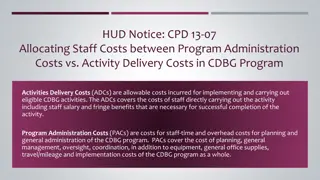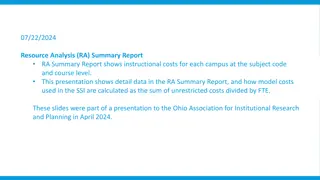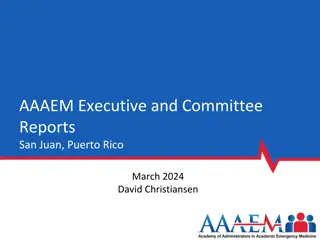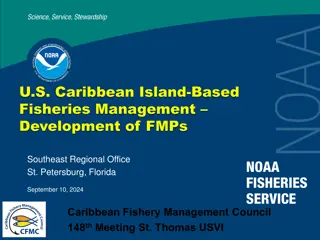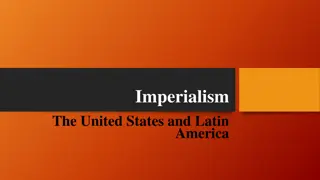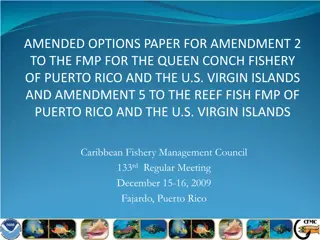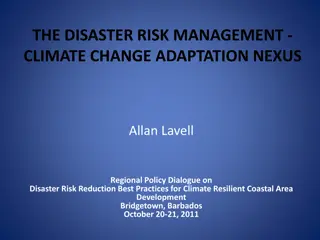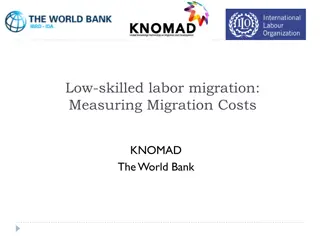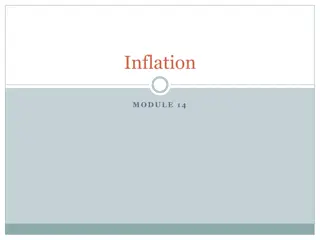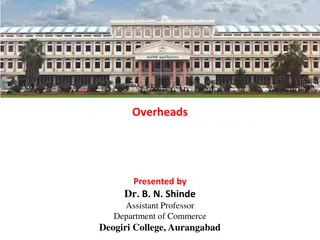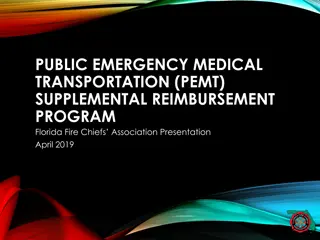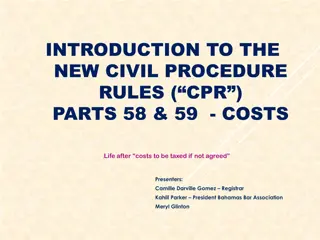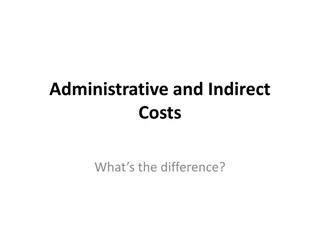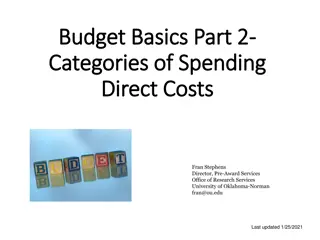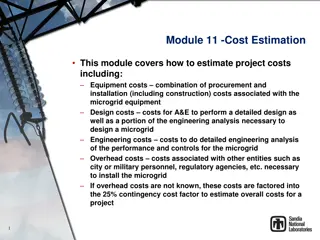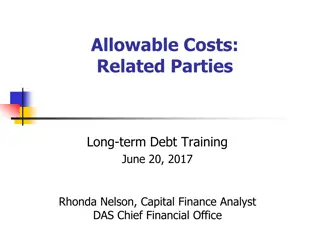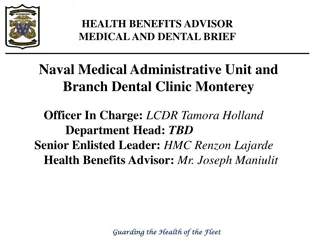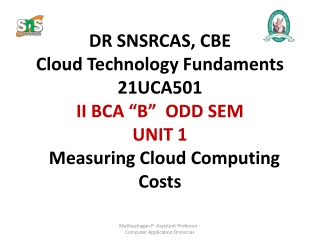Overview of Medical Service Costs in Puerto Rico
This report provides information on the cost of medical services in Puerto Rico, submitted to the Colegio de Médicos-Cirujanos de Puerto Rico. The Custom Research Center, Inc. conducted the research, located at 1650 De Diego, San Juan, PR 00927. Contact them at (787) 764-6877 or (787) 764-6835 for more details.
Download Presentation

Please find below an Image/Link to download the presentation.
The content on the website is provided AS IS for your information and personal use only. It may not be sold, licensed, or shared on other websites without obtaining consent from the author. Download presentation by click this link. If you encounter any issues during the download, it is possible that the publisher has removed the file from their server.
E N D
Presentation Transcript
COST OF MEDICAL SERVICES IN PUERTO RICO Submitted to: Colegio de M dicos-Cirujanos de Puerto Rico http://t2.gstatic.com/images?q=tbn:ANd9GcRSXaVIeC0Pa7fjY_t6DIfE4Jv9c5H_-8ylq6Vyi1vBkETneYSn Custom Research Center, Inc. 1650 De Diego, San Juan, PR 00927 Tels: (787) 764-6877 (787) 7646835 August 2012
Table of Contents Background of the Study Purpose and Objectives Methodology Findings: Survey of doctors in Puerto Rico and related data Demographics and Work Patterns of Doctors Costs for Employees and Contracted Services Costs for Rent and Utilities Costs for Malpractice Insurance Costs for Medical Equipment and Supplies Level of Dissatisfaction with Medical Practice in PR and Reasons to Move Options for Patients when Best Option for Treatment not Available in PR Major Concerns of Doctors in PR Possibility of Scarcity of Doctors in Certain Specialties Findings: Survey of doctors from PR now in USA Demographics of Doctors now in USA Careers and Work Patterns Motivations to Move to USA or Move Back to PR Major Concerns of Doctors now in USA Conclusion 3 7 11 13 14 20 28 32 37 47 49 52 55 58 59 62 65 67 69 2 Custom Research Center, Inc.
Background of the Study Low remuneration to doctors in Puerto Rico from Medicare: Remuneration to doctors in Puerto Rico from Medicare is the lowest among all states and territories. Fees paid by Medicare determined by GPCI: The fees paid by Medicare for medical services are pegged to differences in cost for different geographic areas calculated according to the Geographic Practice Cost Index (GPCI). There are three components used to calculate the GPCI: the cost of physician work the costs of medical practice the cost of malpractice insurance 3 Custom Research Center, Inc.
Background of the Study Physician Work Component of GPCI: Indexing for physician work did not affect Puerto Rico negatively in recent years, because areas in which physician earnings were lower than the national average (set at 1.0) were automatically indexed to the national average (in other words those higher than national average benefited but those lower were not penalized). However, if Congress does not renew this provision for a physician wage floor it will expire at the end of 2012, which would probably mean that the index for physician work in PR would be less than 1.0, further lowering remuneration from Medicare. 4 Custom Research Center, Inc.
Background of the Study The Medical practice costs component of GPCI is calculated on the basis of employee (non-physician) wages, office rent, costs of contracted services (such as accounting and legal services) and other (including equipment, supplies, and maintenance). Four categories of employee costs: registered, licensed practical nurses, health technicians, administrative support staff. GPCI calculated on basis of BLS statistics. Rental index calculated on basis of American Community Survey (ACS). Costs of utilities, such as electricity not taken into account, which is prejudicial to the island, since PR electricity costs much higher then continental US. Costs for equipment, supplies, etc. are not indexed because this category of expenses is regarded as equal in all localities, which may be prejudicial to Puerto Rico, because shipping and related costs to the island make medical equipment and supplies more expensive. 5 Custom Research Center, Inc.
Background of the Study The Medical malpractice insurance costs component of the GPCI is calculated on the basis of information obtained from medical insurance companies and Departments of Health. The data used to calculate the malpractice index for Puerto Rico is more than 10 years old. Concerns of the Colegio de M dicos-Cirujanos de Puerto Rico: The Colegio is concerned that the indexing method used by the Center for Medicare and Medicaid Services (CMS) does not accurately reflect the real costs of practicing medicine on the island. If the index is not adjusted to more accurately reflect real costs, the result may be an exodus of physicians, and shortages of critical medical services for a rapidly aging population. 6 Custom Research Center, Inc.
Purpose The purpose of the study is to analyze the costs of practicing medicine in Puerto Rico, particularly with regard to salaries paid to non-physician employees, physician wages, contracted service costs, medical equipment and supplies, and malpractice insurance, as well as the perceptions of medical practitioners of the trends in costs. The study also aims to determine to what extent the high cost of medical practice and relatively lower remuneration from Medicare has an impact on doctors decisions to relocate to the US mainland or elsewhere. 7 Custom Research Center, Inc.
Specific Objectives Determine the following costs of practicing medicine for doctors in group practice and those with an individual practice in Puerto Rico: Rental costs as well as electricity and water expenses (whether included or separately billed from rent) Non-physician employee wages for nurses, health technicians and administrative support staff Physician wage costs Contracted services costs, such as accounting and legal costs Equipment costs Determine costs for malpractice insurance for general practitioners and specialists 8 Custom Research Center, Inc.
Specific Objectives Explore the perceptions that physicians have of the trends in medical practice costs and malpractice insurance costs in Puerto Rico. Analyze the figures for rent and non-physician wages and determine whether the underestimates the real costs in Puerto Rico. Find out whether medical equipment costs are higher in Puerto Rico than in the United States and estimate to what degree the failure to index these expenses might result in underestimating the cost of medical practice in Puerto Rico. Make estimates of the degree to which medical practice costs as a whole and malpractice underestimated in Puerto Rico and what policies could be implemented to compensate for any unfairness in the remuneration of doctors by Medicare. indexing done by CMS insurance costs are 9 Custom Research Center, Inc.
Specific Objectives Look at the areas of medicine in which shortages of doctors are anticipated. Explore the degree to which medical doctors are satisfied with the remuneration received (in general and specifically from Medicare). Estimate the percentages of doctors presently practicing on the island that are considering moving out of Puerto Rico and explore the reasons why they want to move. Explore the reasons why doctors in Puerto Rico who have moved to the States in the last ten years made the choice to emigrate. Analyze the degree to which there is a serious danger of shortages of doctors in Puerto Rico and make relevant policy recommendations. 10 Custom Research Center, Inc.
Methodology A combination of primary and secondary research instruments were used to meet the specific objectives of the project. A quantitative survey of 281 medical practitioners in Puerto Rico was used to make an estimate of medical practice costs in Puerto Rico, as well as perceptions of the trends in costs, the degree to which doctors are satisfied with remuneration from Medicare, and the percentage of doctors who are considering moving out of Puerto Rico because of dissatisfaction with remuneration for medical services. A quantitative survey of doctors who have emigrated with a sample size of 35 was used to explore the reasons why doctors practicing in Puerto Rico have chosen to move to the US mainland. 11 Custom Research Center, Inc.
Methodology One-on-one equipment companies, insurance agents, that deal with malpractice in Puerto Rico, and personnel of medical associations that represent specific specialties were used to expand upon the information obtained in the quantitative surveys. Medical schools in Puerto Rico also provided additional data. interviews of representatives of medical The data collected from these primary research instruments were compared to secondary data obtained from government sources such as the US Bureau of Labor Statistics, the American Community Survey, CMS, the Puerto Rico Department of Health, as well as statistics maintained by the Colegio de M dicos-Cirujanos, in order to determine whether and to what degree the costs of medical practice in Puerto Rico may be underestimated by the indexing system used by CMS and to make relevant policy recommendations. 12 Custom Research Center, Inc.
Findings: Analysis of Quantitative Survey of Doctors in Puerto Rico and Related Information from One-on-One Interviews 13 Custom Research Center, Inc.
Demographics of Doctors Surveyed: Gender, Age and Type of Practice 281 Doctors in PR 71% 55% 45% 34% 27% 26% 24% 8% 8% M F 24-34 35-44 45-54 55-64 65+ PCP Spec Doctors Practicing in PR 71% of the doctors practicing in PR are male, 27% female (2% didn t respond) 60% of doctors in PR were between 35 and 54 years of age 55% in PR are primary care physicians and 45% are specialists 14 Custom Research Center, Inc.
Where Did You Study Medicine? All Doctors in PR Specialists 78% 53% 19% 18% 8% 8% 8% 6% 4% 3% PR DR Mexico Spain US Over half (53%) of all doctors surveyed studied medicine in Puerto Rico, and a little under 20% each studied in the Dominican Republic and in Mexico. Only 3% in US, and of these doctors, 50% studied in New York state. 78% of specialists studied medicine in Puerto Rico. 15 Custom Research Center, Inc.
Where did You Do Residency and Specialty? Residency Specialty 82% 78% 50% 38% 19% 9% 11% 9% 4% 2% 1% 0% 0% 0% PR US Cuba Mexico NR PR US Cuba NR All Doctors in PR Specialists 78%of all doctors surveyed did their residency in PR and 11% in the United States. Of those who did residency in the US, about one third (31%) did it in New York state. Specialists even more likely to have completed their residency in US than doctors in general. Half of specialists did their specialty in Puerto Rico, and 38% in the US. Of those who did specialty in US, the states most mentioned were New York and Massachusetts. 16 Custom Research Center, Inc.
Work Patterns and Scenarios 74% of doctors surveyed are self-employed or partner in a group, 13% are salaried employees of hospital, clinic, or medical group and 12% are both Work scenario Number of doctors in private group practice Private practice 58% 37% Private hospital 27% 21% Private medical group 26% 18% Share office 16% 8% 8% 7% Public Hospital 1% 5% University 5% 2 3 to 45 to 6 7 to 15 40 NR 12 Government 5% The majority of doctors work in private practice, and many also work in private hospitals or form part of a private medical group. It is less common to share an office without being a partner Of those doctors in private medical groups, most are in a group of two, or a group of three to four. 17 Custom Research Center, Inc.
Medicare and Mi Salud Patients 92% of doctors surveyed treat Medicare patients 65% treat Mi Salud (Puerto Rico government health plan) patients % of Medicare patients % of Mi Salud patients 29% 44% 23% 23% 22% 12% 11% 12% 12% 8% <20% 21-40% 41-60% 61-80% 81-100% <20% 21-40% 41-60% 61- 80% 81-100% 41% of the doctors who treat Medicare patients have practices in which Medicare patients predominate (60% or more of their patients have Medicare) 66% of the doctors that treat Mi Salud patients have practices in which Mi Salud patients do not predominate (40% or less have Mi Salud) 18 Custom Research Center, Inc.
Number and Location of Medical Offices 71% of doctors have only one office, 16% have two, 6% have three or more, and the rest did not respond or said the question did not apply The doctors surveyed reported having offices in 45 different municipalities of Puerto Rico. Most frequently mentioned were: San Juan (24%), Bayamon (8%), Caguas (8%), Ponce (5%), Carolina (5%), Mayag ez (4%) and Manat (4%) 78% have their practice located in an urban area, 7% in a rural area, and 13% in both 59% have an office located in a commercial area, 13% in a residential area, 21% in both, 3% said they did not have an office, and 4% didn t respond 66% said they have an office located near a hospital, 27% said office not near a hospital, and the others didn t respond or said the question did not apply. 19 Custom Research Center, Inc.
Types of Non-Physician Employees Types employed All doctors PCPs Specialists Registered nurse 17% 19% 16% Practical licensed nurse 12% 15% 8% Health technician 35% 6% 70% Administrative personnel 82% 75% 90% 82% of physicians had administrative personnel, 35% have health technicians and less than 20% had registered nurses or practical licensed nurses. Specialists had more health technicians (70%) than all doctors. Type of technicians employed by specialists More specialists employ ultrasound than other types of highly specialized technicians 26% 13% 8% 9% X-ray Ultrasound MRI CT 20 Custom Research Center, Inc.
Difficulty in Finding Qualified Employees Registered nurse 29% Practical nurse 17% Health technician 15% Admin personnel 36% % doctors who have difficulty finding qualified employees Reasons for difficulty: Increasing salaries, difficult to pay salaries 65% 59% 57% 52% Lack of qualified personnel / emigrate for higher salaries 38% 35% 31% 24% Lack of qualified personnel, emigrate better work conditions 20% 18% 19% 11% Lack of qualified personnel/ emigrate better living conditions 16% 14% 19% 10% Lack of qualified personnel few education programs 15% 12% 19% 21% Higher percentages of doctors have difficulty finding administrative personnel and registered nurses. Main reason for hiring difficulties is increasing salaries/difficult to pay, followed by emigration to US to seek higher salaries Doctors most worried about lack of education programs for health technicians and administrative personnel 21 Custom Research Center, Inc.
Total Salary Costs for Employees in 2011 All PCPs Specialists $50,000 or less 51% 74% 24% $50,000 to $100,000 22% 21% 24% $100,000 to $300,000 20% 5% 37% $300,000 to $500,00 3% 0% 7% $500,000+ 4% 0% 8% A majority (73%) of all doctors and of PCPs (95%) report annual salary expenditures for non-physician salaries to be $100,000 or less A majority (52%) of specialists report non-physician salary expenditures over $100,000. 22 Custom Research Center, Inc.
Costs for Employees Average total annual expenses by doctors for staff salaries How have costs for non- physician employees changed? Average cost per doctor 14% Registered nurses $33,169 Increased Practical nurses $15,780 Reduced 16% Health technicians Administrative personnel $67,831 Stayed same 70% $49,520 Estimate of annual cost if hiring doctor of similar expertise to your own All doctors PCPs Specialists Mean annual salary estimate $241,785 $172,262 $325,329 23 Custom Research Center, Inc.
Costs for Employees: Details 70% of doctors said their costs to cover the salaries of non-physician employees had risen, 14% said stayed the same, and 16% said they had reduced. Large numbers of doctors reported using part time nurses and administrative staff, so it is quite possible that the doctors who said costs went down had cut their administrative and nursing staff. For the 46 doctors surveyed who employed registered nurses, the average cost was $33,169. Specialists had higher costs for registered nursing staff ($46,787) than PCPs ($21,918) For the 32 doctors who had practical nurses, the average cost per year for their services was $15,780. Specialists spent an average of $17,140 and PCPS spent an average $15,063 Of the 94 doctors who employed health technicians, the average cost was $67,831. Specialists spent much more on health technicians ($71,506) than PCPs ($10,500) For the 233 doctors who employed administrative personnel the average annual expenditure per doctor was $49,520. Specialists spent $72,547 and PCPs spent $24,357. 24 Custom Research Center, Inc.
Costs per Employee Once the part time employees were eliminated, the numbers were too small to make statistically valid estimates of mean annual salary of registered nurses, practical nurses, healthcare technicians and administrative personnel. However, it was observed that the salaries for full time employees were within the range that could be expected given the latest 2011 statistics of the BLS. For example, in the case of registered nurses, full time salaries ranged from $28,000 to $35,000 while the BLS estimates an average salary of $32,510. It should be noted that nurses salaries have risen dramatically in the last decade according to BLS statistics, which supports the claim by the doctors themselves that the costs for staff salaries have gone up quite rapidly. 25 Custom Research Center, Inc.
Steep Rise in Nurses Salaries BLS Estimates of Mean Annual Salary in PR 2000 Registered Nurses Practical Nurses $20,870 $14,420 2005 $24,270 $16,500 2011 $32,510 $21,550 Registered nurses: average salary increase From 2001 to 2005, increase of 16% From 2005 to 2011, 34% From 2001 to 2011, 56% Practical Nurses: average salary increase From 2001 to 2005, increase of 14% From 2005 to 2011, 31% From 2001 to 2011, 49% To sum up, the increase in nurse s salaries in the past decade was about 50% 26 Custom Research Center, Inc.
Costs for Contracted Services other than Insurance 77% of doctors surveyed contracted services Type of Services contracted % used service Level of costs for contracted Services All PCP Speciali st Accounting 92% 64% 80% 47% Less than $50,000 Air-conditioning 86% 21% 16% 27% $50,000-$100,000 Maintenance/cleaning 81% 7% 2% 13% $100,000-$300,000 Info systems,/data/server 80% 3% 0% 7% $300,000-$500,000 Fumigation 71% 3% 0% 6% $500,000+ Med equip maintenance 67% 64% of all doctors spent less than $50,000 and 21% spent between $50,000 and $100,000 53% of specialists spent more than $50,000 Legal services 58% Security, surveillance 34% Invoicing 10% 27 Custom Research Center, Inc.
Doctors offices Half of doctors surveyed rented their offices Specialists reported greater square footage than PCPs and higher monthly rental costs The mean monthly rental cost was $4,319, and mean mortgage payment was $7,510 Doctors estimate lower rental value for office property than mortgage payment Do you own your office or rent it? 2% Rent 10% Own Both 50% NR or NA 38% Mean square footage, monthly rental cost, and mortgage payment All doctors PCPs Specialists Mean square footage 3,419 1,255 5,753 Mean monthly rental cost $4,319 $1,818 $7,640 Mean monthly mortgage payment $7,510 $4,729 $9,756 Estimated monthly rent for office property owned $4,677 $2,710 $6,541 28 Custom Research Center, Inc.
Increases in Rental Costs How much did rent increase? Did rent increase? 1% 39% 38% Increased 43% Same 55% Decreased 13% 11% <10% 11-20% 21-30% 31% + 55% said rent increased in 2011 Of those whose rent increased, 38% said less than 10% and 39% said between 11% and 20% Reasons include rise in living costs and rentals, increased maintenance and including utilities Reasons why rent increased N=8 0 28% Increased living costs (general) Increased rent/change of owner 24% Increased maintenance expenses 14% Now includes water and electricity 10% 29 Custom Research Center, Inc.
Increases in Mortgage Costs How much did mortgage payment increase? Did mortgage payment increase? 3%4% Increased 69% 31% Same Decreased 20% 62% 6% 11% NR <10% 11-20% 21-30% 31% + 31% said mortgage payment increased in 2011 Reasons why mortgage payments increased N=3 5 Of those whose payment increased, 69% said less than 10% Increased insurance costs 80% Increased property taxes 71% Reasons include increased insurance costs, increased property taxes and special property tax surcharge Imposition of special property tax surcharge 83% 30 Custom Research Center, Inc.
Utilities Cost Average monthly payments for utilities All types of doctors PCPs Specialists Electricity $1,119 $641 $1,869 Water $178 $166 $197 Security $392 $315 $508 Total for utilities plus security $1,689 $1,122 $2,574 Average monthly rental costs Average monthly rent $4319 $1818 $7,640 Utilities as percentage of rent Electricity cost as % of rent 26% 35% 24% All utilities plus security as % of rent 39% 62% 34% 31 Custom Research Center, Inc.
Malpractice Insurance: Coverage 4% $1,000,000/$3,000,000 4% 8% 3% $500,000/$1,000,000 1% 2% 3% $250,000/$500,000 2% 3% 57% $100,000/$300,000 70% 70% 3% $300,000 4% 7% 2001 3% $100,000 3% 3% 2006 9% Other 8% 4% 2011 18% No response 8% 3% Not much change in the pattern of malpractice insurance coverage in the last ten years. The large majority of physicians have $100,000/$300,000 coverage. The percentage that opted for much larger coverage of one million to 3 million increased from 4% in 2001 and 2006 to 8% in 2011. Among specialists , 7% had 1 to 3 million coverage in 2001, 5% in 2006, which increased to 13% in 2011. 32 Custom Research Center, Inc.
Malpractice Insurance: Leading Insurers and Annual Cost Most doctors (74%) have malpractice insurance with SIMED, 13% with Triple S, and 5% with CNA Year All PCPs Specialists 2011 mean annual cost $5,343 $3,529 $7,538 % increase from 2006 to 2011 19% 10% 25% % increase from 2001 to 2011 57% 39% 75% 2006 mean annual cost $4,501 $3,201 $6,046 % increase from 2001 to 2006 32% 26% 40% 2001 mean annual cost $3403 $2,545 $4,319 Between 2001 and 2006 the cost of insurance increased by 32% for all doctors and a whopping 40% for specialists. The rate of increase slowed somewhat from 2006 to 2011, but was still 19% for all doctors and 25% for specialists. If we look at the increase over a ten year period, the average for all doctors surveyed was a 57% increase and 75% for specialists. 33 Custom Research Center, Inc.
Reasons for Higher Malpractice Insurance Costs The previous slide shows that most doctors maintained coverage of $100,000 /$300,000 and the percentages taking higher coverage increased only slightly in the last ten years. Therefore, it is logical to conclude that most of the increase in cost for malpractice must have come from increased premiums for the same coverage. A majority (56%) of doctors said that the reason for the rise in their malpractice insurance costs was an increase in the premiums charge by insurance companies, 4% attributed the increase to increased coverage, and 40% did not respond In 2003, the Puerto Rico insurance regulator proposed a hike in premiums of 53%, which might have some bearing on the steep hike in premiums reported by doctors for the period between 2001 and 2006. 34 Custom Research Center, Inc.
Doctors and Insurance Agents Agree: Malpractice Insurance Inadequate 47% of doctors consider their malpractice insurance to be adequate, 48% say it is not adequate, and 5% did not respond. Doctors who do not think they have adequate coverage indicated that the following limits would be adequate: 7% mentioned coverage under $250,000 18% think coverage should be $250,00/$500,000 38% think coverage should be $500,000/$1million or $1million 21% say $1million to $3million, $1million to $5million, etc. Insurance agents who deal with malpractice insurance confirm that the usual limit is $100,000 to $300,000 though for some specialties it may be considerably higher. In general they think that coverage should be increased, but in actual fact they say that coverage has increased very little in the past five or ten years, thus coinciding with the perceptions of doctors themselves. Several agents suggested that it is a policy of leading insurer companies to keep coverage low. 35 Custom Research Center, Inc.
Reasons Not to Have Adequate Malpractice Insurance Considerting retirement/close office 8% Considering moving practice outside PR 16% Considering increasing my coverage 15% Evaluating different company offers 21% 73% Policy premiums too high The main reason doctors do not carry sufficient malpractice insurance is because they find the premiums charged by insurance companies too high 36 Custom Research Center, Inc.
Cost to Establish a New Office with Modern Medical Equipment Year All PCPs Specialists 2011 mean annual cost $502,037 $121,339 $955,564 % increase from 2006 to 2011 19% 63% 16% 2006 mean annual cost $420,961 $74,361 $827,077 The doctors surveyed estimated that it would require an investment of about half a million dollars to set up a new office with the modern medical equipment required in 2011, which represented a 19% increase over the cost in 2006. Specialists would require much greater investment (almost a million dollars in 2011 compared to about $120,000 for PCPs). Although PCPs costs were much lower, their costs increased at a much higher rate in the last five years. 37 Custom Research Center, Inc.
Annual Equipment Costs: Repair, Maintain, Buy New, Replace Old Current costs for: All PCPs Specialists Buy new equipment $52,465 $14,623 $95,960 Replace old equipment $33,472 $5,293 $64,435 Maintenance $35,646 $5,454 $65,043 Repair $14,275 $3,049 $26,241 Total $135,858 $28,419 $251,679 Specialists spend on the average a quarter of a million dollars annually to buy new equipment they need and replace old equipment, as well as repair and maintain equipment. Custom Research Center, Inc. 38
Reasons Not to Have State of the Art Medical Equipment Only 21% of doctors say their office has state of the art equipment, 65% say it does not, and the rest said question doesn t apply or didn t respond Reasons why doctors don t have state of the art equipment Too expensive 91% Newest not better than what I have 24% Newest not better for patients 18% Considering moving practice out of PR 16% Evaluating different company offers 13% Researching equipment available 12% Considering retirement/close office 9% The main reason doctors do not acquire state of the art equipment is high prices (91%) A total of 42% either think the new equipment isn t better than what they already have, or isn t better for patients 39 Custom Research Center, Inc.
Higher Prices for Medical Equipment in Puerto Rico 93% of doctors buy medical equipment from local firms, 62% buy from US firms, and 3% buy from other countries. 82% say that prices for medical equipment are higher in Puerto Rico than in the US mainland. The doctors who said prices are higher in Puerto Rico were then asked to estimate the percentage difference. The mean estimate was 23% higher prices in Puerto Rico than the US mainland. 95% of doctors thought that a major factor responsible for higher prices in Puerto Rico was the cost of shipping, transportation and other import costs, and 58% said that lack of competition was an important factor. One representative of a medical equipment company also said that doctors in the States have a larger number of firms to choose from which would explain lower costs. The representative was specifically referring to comparative costs to equip a cardiologist s office in Puerto Rico and the United States. 40 Custom Research Center, Inc.
Shipping Costs for Medical Equipment When asked whether shipping costs are included in the price, 46% of the doctors said yes, 19% said they were charge separately for shipping, 15% said it depends on the supplier, and the rest didn t know or didn t respond Most doctors (90%) said they didn t know what percentage of the total price is to cover shipping costs Among those doctors who gave an estimate, the mean estimate for the percentage of the total price that corresponds to transportation costs was 16% Most medical equipment company representatives interviewed agreed that shipping costs increased the price, but were reluctant to specify by what percentage. One representative said the increase was about 10 to 15%, which is in line with the estimates given by doctors, and another said 5%. One representative said it is not only shipping costs, but other related costs, like loss or vandalism while in storage, that have to be accounted for. 41 Custom Research Center, Inc.
Medical Equipment Insurance 42% of all doctors reported having medical equipment insurance in 2011 Among specialists, 60% carried equipment insurance, compared to 28% of PCPs The companies most frequently mentioned: Universal (21%), Triple S (12%), Mutual Life (12%), Integrand Universal (9%), Topcon Insurance (9%), Cooperativa de Seguros M ltiples (8%) and Mapfre (8%) ALL PCPS Specialists Average Medical Equipment Insurance Annual Premium $6,908 $2,577 $9,041 42 Custom Research Center, Inc.
Annual Expenses for Medical Supplies Year All PCPs Specialists 2011 mean annual cost $37,770 $25,577 $50,891 % increase from 2006 to 2011 24% 74% 7% 2006 mean annual cost $30,371 $14,735 $47,624 The average annual expense for medical equipment among all doctors surveyed was $30,371, which increased to $37,770 in 2011 (24%) Specialists reported much higher expenses for materials than PCPs. Although PCPs costs were much lower, their costs increased at a much higher rate in the last five years. 43 Custom Research Center, Inc.
Higher Prices for Medical Supplies in Puerto Rico 100% of doctors buy medical supplies from local firms, and 75% buy from US firms. 81% say that prices for medical supplies are higher in Puerto Rico than in the US mainland The doctors who said prices are higher in Puerto Rico were then asked to estimate the percentage difference. The mean estimate was 22% higher prices in Puerto Rico than the US mainland for medical supplies. 82% thought that a major factor responsible for higher prices in Puerto Rico was the cost of shipping, transportation and other import costs, and 50% said that lack of competition was an important factor 44 Custom Research Center, Inc.
Shipping Costs for Medical Supplies Does the price include transportation costs? 47% Included in total price 10% Paid separately 16% Depends on supplier 17% No response 11% Don t know Most doctors (93%) said they didn t know what percentage of the total price is to cover shipping costs The mean estimate for the portion of the total price that corresponds to transportation costs was 14% 45 Custom Research Center, Inc.
Factors Contributing to High Medical Practice Costs in PR 100% of doctors said overall costs to practice medicine in PR were higher than in 2001 (96% said much higher) 97% said costs are higher than in 2006 (78% said much higher) Why have the overall costs of practicing medicine risen? Low fees paid by health insureres 93% High electricity costs 93% Other utilities cost 87% Higher personnel costs 84% High cost medical supplies 84% Low Medicare fees 78% High medical equip costs 76% High malpractice insurance rates 70% High rent/mortgage 63% 46 Custom Research Center, Inc.
Level of Dissatisfaction with Medical Practice in PR and Intentions to Move 82% dissatisfied with medical salaries/earnings in Puerto Rico 21% are somewhat dissatisfied and 61% are very dissatisfied 49% think that Puerto Rico is not a good place to establish and office 59% of doctors survey have considered moving their medical practice out of PR Of the 59% who have considered moving, 99% have considered the US The states most frequently considered: Florida (44%), Massachusetts (12%) and Texas (10%) Of the six doctors who are considering moving to another country, 50% are considering Spain 47 Custom Research Center, Inc.
Reasons to Consider Moving Practice out of Puerto Rico Economic reasons, higher salary 96% Better working conditions 90% Higher fees from health insureres 90% Higher Medicare fees 77% Less payment problems health insurers 64% Better professional development 63% Better educational opportunities 51% Less payment problems Medicare 50% Better personnel available 47% 48 Custom Research Center, Inc.
Patients Sent Outside Puerto Rico for Treatment 19% of doctors surveyed said they sent patients for treatment outside Puerto Rico because treatment could not be done here Of the doctors who said how many patients were sent, 35% sent one or two patients, 40% sent between 3 and 8 patients, 21% sent between 10 and 15, and 4% sent 20 to 25. Of the doctors who specified where they sent these patients, 100% said USA Of the 44 doctors who specified for which procedures they sent their patients to the US: 13 (29%) mentioned procedures having to do with cancer treatment or tumor removal, including: cancer treatment (5), surgery and treatment of cancer of the head and neck (2), radio embolization (2) treatment of cancer of the eye (1), removal of eye tumor(1), surgery for cancer of the esophagus (1), removal of mass from colon and bladder (1) 11 (25%) mentioned procedures having to do with the cardiovascular system, including: cardiovascular surgery (3) open heart surgery (2), implant of percutaneous cardiac valves (2), coronary revascularization using atherectomy (2), vascular surgery (1), revascularization of lower extremities (1) 7(16%) mentioned liver transplant 4 (9%) mentioned neurosurgery or the neurosurgical procedure percutaneous discectomy 2 (5%) mentioned each of the following: lung transplant, robotic prostrate, treatment for autism 49 Custom Research Center, Inc.
Alternative Treatments for Patients When Best Option not Available in PR 10% of doctors surveyed said they suggested alternative treatments because the best option was not available in Puerto Rico and the patient did not have the resources to go elsewhere Of the doctors who said how many patients were sent, 30% sent one or two patients, 33% sent between 3 and 8 patients, 15% sent between 14 and 30 patients, 19% sent 35 to 69, and 4% sent 200. Of the 29 doctors who specified for which procedures they had to consider alternatives: 6 (21%) mentioned procedures having to do with the cardiovascular system, including: correction of structural defects of the heart through percutaneous catheters (2) cardiothoracic surgery (2), aortic coarctation (1) vascular surgery revascularization of lower extremities (1) cardiovascular surgery 6 (21%) mentioned procedures having to do with cancer treatment or tumor removal, including: oncologic surgery (2), surgery and treatment of cancer of the head and neck (2), removal of mass from colon and bladder (1), removal of eye tumor(1) 2 (7%) mentioned each of the following: neurosurgery, Balloon sinuplasty. 50 Custom Research Center, Inc.
